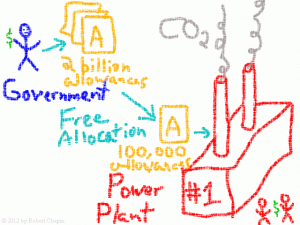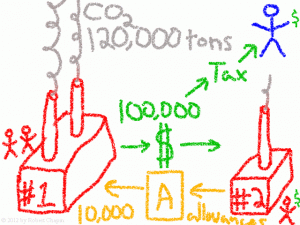
Behold the combination of my graphical design talent with my ability to explain the inner workings of the European Union’s Emissions Trading System (EU-ETS). Both are amazing, I know.
Here’s the background. Europe (the blue stick figure) has been concerned about air pollution and global warming for many years. In 2005, to reverse the trend of increasing pollution, Europe invented a new market instrument called the EU Allowance (EUA). That was how the trading system began.
Enough background, though. I want to explain the less-technical parts first. Instead of using the name EUA, I will call those things Alpha Bills to make them sound more like a currency.
To get a trading system started, Europe orders up two billion Alpha Bills from its printing presses and starts doing some trading of its own. The blue stick figure visits Power Plant #1 and says, “I would like to purchase your air pollution. I see that you are producing 100,000 metric tons of CO2 every year, so I will give you 100,000 Alpha Bills per year in exchange for your pollution. The only catch is, if you produce more than 100,000 metric tons, you will either have to get someone else to buy the excess or you will have to pay me a fine of 100 dollars per ton.” Of course, the power plant is European and doesn’t actually have dollars, but I’m trying to keep this simple. Both the blue stick figure from the government and the red stick figures at the power plant get to keep their dollars because no real money has changed hands yet.

Before I explain what happens next, I have to explain Europe’s master plan. It’s called a “cap and trade” system. In theory, by capping the number of Alpha Bills at two billion, Europe could prevent the growth of pollution. Everyone has to play their part, though. Europe fully expects Power Plant #1 just can’t help but make 20,000 metric tons extra CO2 instead of stopping at 100,000 total. Well thank goodness for the red stick figure at Power Plant #2. He sees that Power Plant #1 is headed for trouble and offers to help. “I have 10,000 extra Alpha Bills because I had to shut down my plant for repairs. I will buy some of your extra air pollution, but I won’t do it for free. The guys at Power Plant #3 offered me $9 per ton in exchange for my Alpha Bills. I think $10 is a fair number.”
Power plants one and two agree to exchange 10,000 Alpha Bills for 100,000 dollars. Power Plant #2 turns a $100,000 profit, Power Plant #1 avoids part of a steep fine, and the government gets to collect taxes on the trade. It’s a win-win-win deal. Even though Power Plant #1 has to spend some real money, it can plan ahead and pass that expense to its customers.
At the end of the first year, Power Plant #1 has a total of 120,000 tons of CO2 emissions, but only 110,000 Alpha Bills. Since nobody bought the extra pollution, there is now a fine due of 10,000 excess tons times $100 per ton. That’s $1 million.
Now the blue stick figure turns a profit of $1 million, and the power plant incurs a substantial new cost of doing business. Europe’s theory pays off, and the power plant is motivated to reduce pollution as much as is practical.
It’s an interesting story so far, but does it work in reality?


Well, no.
When the European Union first tried this back in 2005, it allocated far too many EUAs. Most of the polluters didn’t exceed their allocations, and the ones who did had almost no competition to buy more. This reality disrupted the market, which crashed in 2006 and eventually tumbled into a total collapse.
Hopefully, the lesson learned by the EU is that the price of a potential fine will not set the market price for free allocations. More likely, the market will determine how many allocations are needed from year-to-year, causing the tail to wag the dog.
For more perspective on this first attempt at cap and trade, I recommend reading the EU ETS Over-allocation by a self-proclaimed Carbon Economist.
Round 2, Fight!

Fortunately, this story didn’t end in 2007. The European Union restarted the ETS in 2008 with new allocations.
Now that some of the problems are worked out, the EU plans to ratchet down the number of allocations every few years. By lowering the number of EUAs, the amount of air pollution should go down, and the amount of fines collected should go up. Since everything else has gone according to plan so far, this should work out perfectly, right? But wait, it gets far, far more complicated.
Starting January 1 of this year, international air travel has been included in the EU-ETS. In other words, the blue stick figure has been going around to the red stick figures at the international airlines and giving them Alpha Bills. But unlike all of the red stick figures from before 2012, these aren’t in Europe. They’re all around the world, including in the United States. The blue stick figure says, “There’s a new rule starting this year. Anyone who lands in Europe has to sell all of their pollution for the entire flight.” Since the airlines prefer to continue landing at destinations in the EU, they are adding the expected cost of trades and fines to airfares. There’s more.
Starting next year, the Alpha Bills will be sold at auction instead of being allocated for free. The blue stick figure will be profiting from sales, trades, and fines relating to the Alpha Bills. This is starting to sound nothing at all like a currency or a free market for trade. But of course, even that isn’t so simple.

Enter the reductions. These are the other flavors of Alpha Bills. Instead of being called EUAs, they’re called ERUs and CERs. They have the same value in the sense that they are good for avoiding the fee for one ton of CO2 emissions. The only thing that makes them different economically is that they aren’t being auctioned by the EU. These other Alpha Bills are available for direct purchase, like investing in a clean energy project, or they can be sold into the market at perhaps the same price point as the EUAs.
I have a prediction for where this is going to lead. Europe is capable of developing clean energy sources only so fast, forcing many businesses to export or outsource their pollution-producing operations to other continents. Everyone else must face the rising cost of the cap and trade system. If the cap gets ratcheted down too fast, faster than the market is able to correct for the scarcity of allowances and reductions, then the market would enter a frozen condition quite the opposite of the crash of 2006. The $100 fine imposed by the EU also imposes an artificial $100 price ceiling on EUAs. Any price point at or above $100 would signal that there are no sellers left in the market, and trading would effectively stop. This would also signal that the cap has effectively failed to limit CO2 emissions. The only alternative outcome would be the Wag the Dog scenario, where the EU would have to raise the cap in response to market forces.
As for aviation, this EU-ETS plan seems to be going nowhere fast. With the end of the year approaching, Europe was forced to concede that the current political environment will not tolerate a government’s imposition of fees along the entire route of an international flight. Last week, President Obama signed a new law blocking U.S. participation in the EU-ETS. It’s no coincidence that the EU has proposed suspending the enforcement of the ETS on international aviation through 2013.

ICAO, the body that does govern most international flights is now working on a plan for other countries to agree on. That plan will be a fascinating topic in the future, I’m sure. For now, it is sufficient for the world to kick the ball down the road another year. In my opinion, a convoluted cap and trade system is not the way forward for aviation. What makes more sense to me is fuel economy standards, like those being imposed on car owners in California or automobile manufacturers in Michigan. Let’s get the 1% worst-polluting airplanes out of the skies, and then see how much of a difference that makes before imposing other fees or restrictions.
If you have any thoughts on this topic, please leave a message below.
Also, congratulations on making it through this article.
I hope the stick figures helped explain things.
Enjoy.
6 responses to “Emissions Trading Explained, With Stick Figures”
Excellent post, Robert. I like your idea of getting the worst polluting airplanes out of the skies. Love the stick figures.
This gets my vote for the world famous “Best Senior Seminar Blog Post” of the year. Very interesting post and it explained many things in detail. Do you think that the ICAO plan (if ever devised) will agree or be compatible with the EU plan?
Thank you, Joe.
I think the EU plan for international aviation doesn’t have a leg to stand on, politically. If or when ICAO comes up with a pollution control system, it will have to be compatible with the Kyoto Protocol as well as the systems already set up by the member states. The airlines will enjoy the flexibility of a globalized solution.
I agree with Joe. Could you share some of this tonight for those who haven’t read it?
Bobby, your pictures are awesome! I really think you should consider a career path in fine arts :-p
But anyways, interesting how the blue stick figures (Europe) are so concerned with the environment, yet everyone always views the U.S. as having a high concern for the environment.
@Ryan: Outside of the USA it’s certainly not true that “everyone always views the U.S. as having a high concern for the environment.”!! (In fact, I know people *within* the USA who would be astonished at that idea.)